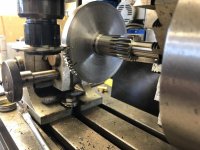jwearing
Cast Iron
- Joined
- Aug 26, 2017
- Location
- Bay Area, California




I finally opened the grease gun.
I am using the Lubriplate 1241 in my T&G for the last few years- in apron etc.
Here's a question for the PIV experts:
The PIV is lubed, the chain is tensioned, and I'm trying to set the RPM stops. The speed adjustment turns easily through the middle and low end of the speed range, however it gets tight and I can't go higher than about 1100rpm (it should go up to 1380rpm, input is 690rpm).
I fiddled with the chain tension but it didn't help. Is there anything else that can cause this? I would like to avoid disassembling again if possible.
First off you have to set the stops on the bench when servicing.Why? Just to avoid the problems you now have.If someone changed a pulley size then you have no idea if the stops are correct or not since you are trying to set to a desired rpm not what the unit is possibly set for.The importance of setting the stops is to keep the chain from contacting the splined shafts at either end of its adjustment.
Pull the indicator dial off you should be able to turn the nuts if you can get to them in the position it is installed.Otherwise it doesn't look like any more than a 1-2 hr job,just bit the bullet!
So back to your problem,on the bench you couldn't adjust one way.Its been about 5 years since I went through one but I think either the thrust yokes or the adjuster arms are offset so installing them backwards will keep from expanding all the way.If you are able to spin the traveling nuts freely to the fixed stop nuts then that rules out bad threads.Did you make sure that the pulleys were in line at 1:1?Was the chain tensioner centered at 1:1?The control screw and chain pivots must be adjusted within 1/2 thread pitch of each other.







Are you going to use turcite or moglice to restore the height of the carriage? Moving the lead screw and drive rod would be a near impossible job.
I haven't decided if I want to build up the tailstock base, or scrape the headstock down to match..
Scraping the headstock down is a "VERY BIG JOB" !!
I did it on mine, because I didn't have any option.
There are a lot of surfaces to get "straight, flat, parallel and in line". If it fits the re-scraped bed ok I vote to not meddle with it.
Just my $0.02 cdn, for what that is worth....;-)
Pete
Notice
This website or its third-party tools process personal data (e.g. browsing data or IP addresses) and use cookies or other identifiers, which are necessary for its functioning and required to achieve the purposes illustrated in the cookie policy. To learn more, please refer to the cookie policy. In case of sale of your personal information, you may opt out by sending us an email via our Contact Us page. To find out more about the categories of personal information collected and the purposes for which such information will be used, please refer to our privacy policy. You accept the use of cookies or other identifiers by closing or dismissing this notice, by scrolling this page, by clicking a link or button or by continuing to browse otherwise.
